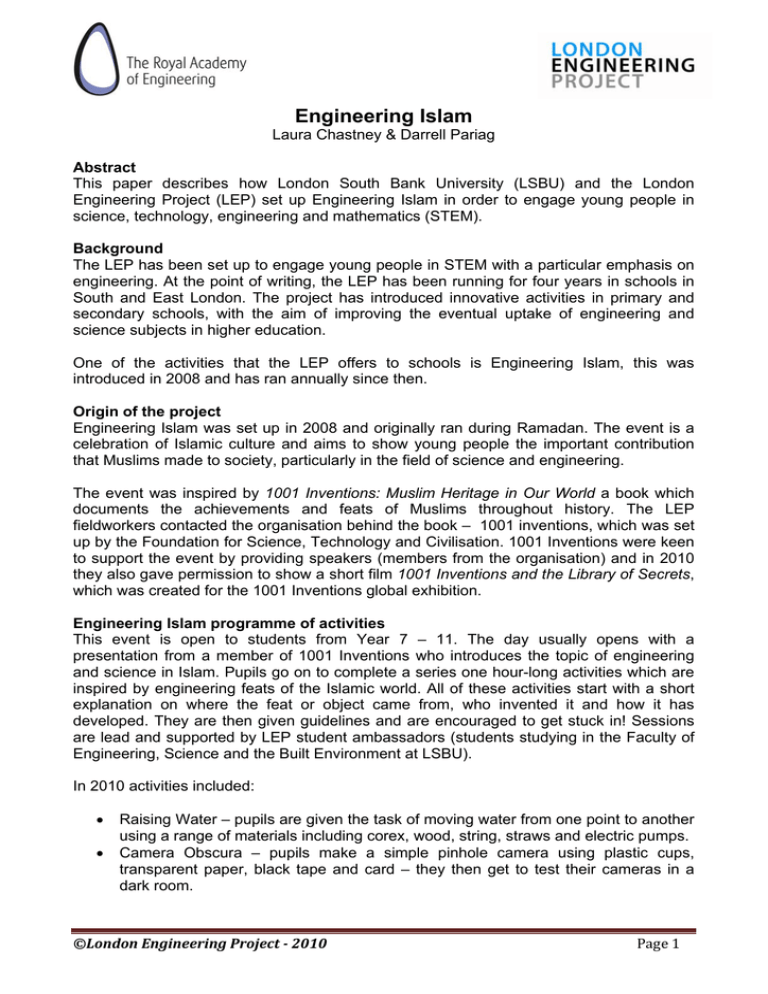Engineering Islam - National HE STEM Programme
advertisement

Engineering Islam Laura Chastney & Darrell Pariag Abstract This paper describes how London South Bank University (LSBU) and the London Engineering Project (LEP) set up Engineering Islam in order to engage young people in science, technology, engineering and mathematics (STEM). Background The LEP has been set up to engage young people in STEM with a particular emphasis on engineering. At the point of writing, the LEP has been running for four years in schools in South and East London. The project has introduced innovative activities in primary and secondary schools, with the aim of improving the eventual uptake of engineering and science subjects in higher education. One of the activities that the LEP offers to schools is Engineering Islam, this was introduced in 2008 and has ran annually since then. Origin of the project Engineering Islam was set up in 2008 and originally ran during Ramadan. The event is a celebration of Islamic culture and aims to show young people the important contribution that Muslims made to society, particularly in the field of science and engineering. The event was inspired by 1001 Inventions: Muslim Heritage in Our World a book which documents the achievements and feats of Muslims throughout history. The LEP fieldworkers contacted the organisation behind the book – 1001 inventions, which was set up by the Foundation for Science, Technology and Civilisation. 1001 Inventions were keen to support the event by providing speakers (members from the organisation) and in 2010 they also gave permission to show a short film 1001 Inventions and the Library of Secrets, which was created for the 1001 Inventions global exhibition. Engineering Islam programme of activities This event is open to students from Year 7 – 11. The day usually opens with a presentation from a member of 1001 Inventions who introduces the topic of engineering and science in Islam. Pupils go on to complete a series one hour-long activities which are inspired by engineering feats of the Islamic world. All of these activities start with a short explanation on where the feat or object came from, who invented it and how it has developed. They are then given guidelines and are encouraged to get stuck in! Sessions are lead and supported by LEP student ambassadors (students studying in the Faculty of Engineering, Science and the Built Environment at LSBU). In 2010 activities included: • • Raising Water – pupils are given the task of moving water from one point to another using a range of materials including corex, wood, string, straws and electric pumps. Camera Obscura – pupils make a simple pinhole camera using plastic cups, transparent paper, black tape and card – they then get to test their cameras in a dark room. ©London Engineering Project ­ 2010 Page 1 • Scentsations – pupils are given a range of essential and fragrance oils which they can combine and add to a carrier oil to make a new unique scent. The LEP approach The LEP aims to engage girls in engineering and always aim to have an equal representation of male and female participants at events. The fieldworkers encourage teachers to bring at least 50% of girls along to this activity. The LEP also aims to provide a range of roles for pupils and tries to ensure that ambassadors come from a range of backgrounds and that at least 50% are female. The ambassadors are trained to in ensuring that female participants are fully involved in activities. References For more information on the London Engineering Project visit: www.thelep.org.uk For more information on 1001 Inventions visit: http://www.1001inventions.com/ ©London Engineering Project ­ 2010 Page 2





